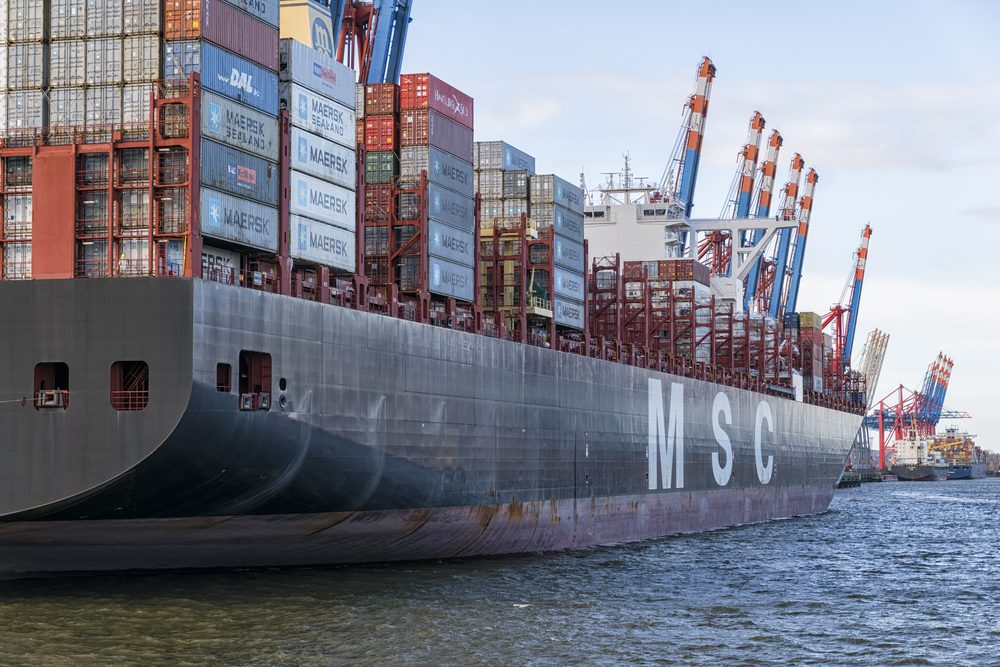Geopolitics, High Bids, and U.S. Pressure Cloud COSCO’s Global Port Ambitions
COSCO Shipping Ports is facing "challenges" with its international investments amid pressures from the U.S. trade war, its managing director said in Hong Kong on Thursday.

File Photo: OnkelKrischan / Shutterstock.com
By Mike Wackett (The Loadstar) – Another containership fitted with an exhaust gas cleaning system (scrubber) is added to the global fleet every 10 hours, according to Alphaliner data.
However, the race to get scrubbers retrofitted on ships ahead of IMO 2020 regulations on 1 January has resulted in a significant extension of the budgeted downtime for many vessels. Some vessels are taking up to 100 days to be equipped as queues grow at yards.
Despite its early proactive stance on scrubbers as a cost-effective option to comply with the IMO’s 0.5% sulphur cap, second-biggest carrier MSC has seen its ship planning severely disrupted by the delays.
“MSC has been the most badly affected, with at least 15 of its ships clocking yard stays of over 80 days,” said the consultant.
“The yard delays are also causing severe congestion, with at least five MSC ships waiting for up to eight weeks to enter repair yards, those in the Zhoushan region in China especially congested in the last two months.”
A source within MSC told The Loadstar recently its planners were “pulling their hair out” at “the lack of visibility” on when ships would return to the network.
“Unlike the ports, kicking [repair yards] doesn’t seem to work, which is very annoying as we were one of the original pioneers of scrubbers. But now everybody has jumped on the bandwagon, it has caused chaos,” he said.
“These guys have clearly oversold their product and suckered-in shipowners and carriers with over optimistic predictions on redelivery times,” he moaned.
For the larger ships, Alphaliner estimates the cost of vessel downtime for carriers could be as much as $50,000 a day, severely denting the operational budgets of the container lines in Q4 and the first quarters of next year.
MSC and some of its pro-scrubber peers are having to bear the “pain” of these costs now, but they will look to recoup this and the cost of the scrubber system itself in a relatively short time, providing the ‘spread’ between current industry staple HFO (heavy fuel oil) and LSFO (low-sulphur fuel oil) remains at around $250 per ton.
Carriers are also having to dig deeper into their pockets to secure replacement charter tonnage. And with the larger sectors “sold out”, carriers are extending current charters for periods of up to five years, which was virtually unheard of just 18 months ago.
In fact, Hapag-Lloyd recently extended the charter of two 11,000 teu Navios-owned vessels by four years and eight months at a daily rate of $27,300. This was twice the hire rate paid by Maersk for the ships two years ago, but less than the $35,000-$40,000 ships of this size can currently command.
Leading scrubber lines, such as MSC and Evergreen, are looking for cover to take them well into next year.
“For carriers with substantial scrubber programmes, periods of 12 months allow the planners to fill the sailing gaps left by the successive withdrawals of ships for scrubber retrofits until the second half of 2020,” said Alphaliner.
The Loadstar is fast becoming known at the highest levels of logistics and supply chain management as one of the best sources of influential analysis and commentary.
Check them out at TheLoadstar.co.uk, or find them on Facebook and Twitter.

Sign up for gCaptain’s newsletter and never miss an update

Subscribe to gCaptain Daily and stay informed with the latest global maritime and offshore news


Stay informed with the latest maritime and offshore news, delivered daily straight to your inbox
Essential news coupled with the finest maritime content sourced from across the globe.
Sign Up